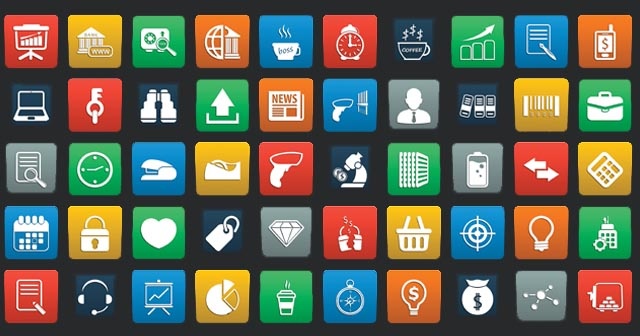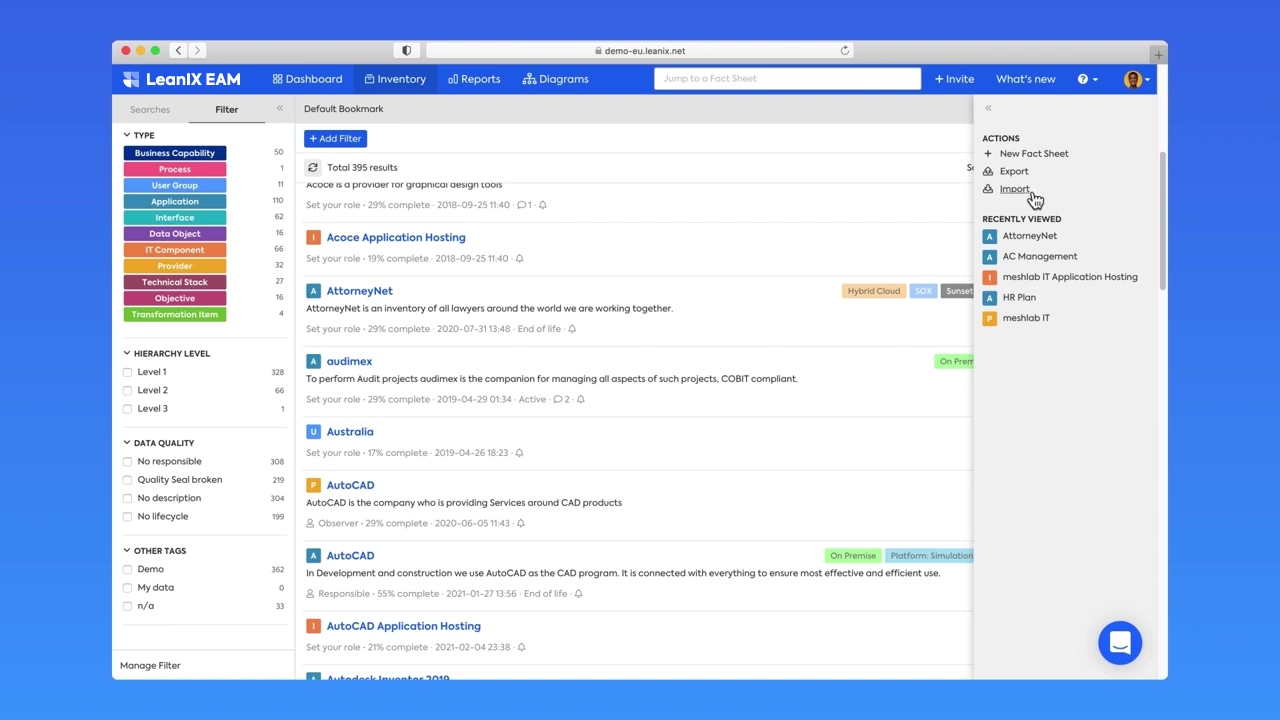
Application rationalization vs application consolidation: which methodology is the right choice for your organization? Let's explore the pros and cons of each.
Application rationalization is usually about cutting back and streamlining your application portfolio. Alternatively, you could undertake an application consolidation initiative and replace your disparate tools with a single platform like SAP or Microsoft Office 365.
Whether it's best that your application portfolio is made up of best-of-breed tools from a selection of vendors, or one, single platform that accommodates all your needs, will depend on your organization and business strategy. Yet, understanding your needs is a challenge in itself.
Getting a better picture of your application portfolio and business needs requires the right tool. Find out more about how the LeanIX EAM can empower your application rationalization efforts:
LEANIX EAM USE CASE: Application Rationalization
Using the information our EAM provides to you, you can confidently decide whether application rationalization or application consolidation is best for you. Let's consider the merits and challenges of each method.
What Is Application Rationalization?
Application rationalization is the process of organizing, synergising, and streamlining an organization's software application portfolio. This is primarily done to reduce expenditure by eliminating duplicate applications, but also to improve efficiency and increase capabilities.
Running regular application rationalization initiatives is essential for maintaining business agility and aligning your strategy with your software toolset. Still, only 15% of organizations do so, according to our 2023 IT Cost Optimization Survey.
READ: Application Rationalization Key To 2023 IT Cost Optimization
There are, however, various different methodologies when it comes to application rationalization, including application consolidation. The traditional strategy of streamlining and removing unneeded applications has a set of pros and cons:
Application Rationalization Advantages
Minimalism:
Cutting the number of applications you use back to the minimum provides various benefits. As well as reducing costs with each application you eliminate, you cut back hosting spend, there are fewer apps to train your employees to use, and a less complex application portfolio is easier to migrate to the cloud.
Strategic alignment:
Traditional application rationalization helps redirect software investment into areas of strategic focus. Spending more on mission critical apps and less on nice-to-have applications ensures the highest return on investment.
Minimal migration:
Eliminating unneeded applications in favor of apps that are already in use means there's no need to migrate your users to a new platform. This will make retraining, change management, and data migration far easier.
Application Rationalization Disadvantages
Lack of cohesion:
Application rationalization is a delicate process. Done haphazardly, rationalization can pick your application portfolio apart and leave it made up of disparate, incompatible apps.
To ensure success, you need to fully understand all the facets of each of your applications and their relation to business capabilities. You also need to model your target application portfolio and the path to get there.
That's why enterprise architects make use of the LeanIX EAM in their application rationalization efforts:
LEANIX EAM USE CASE: Application Rationalization
Loss of innovation:
While focusing on your business strategy is efficient, it closes the door to discovering new revenue streams. Applications that seem irrelevant to business strategy could be supporting innovative value streams that may eventually bear fruit.
Cutting the resources of teams working outside of your core strategy could be stifling innovation. Investment in experimentation may be key to success.
Capability gaps:
A key challenge of application rationalization is ensuring your application portfolio covers all the necessary tools you need to support your business capabilities. It's far too easy to realize a seemingly unnecessary tool was needed for some obscure functionality after you've eliminated it.
This is why it's crucial to map your applications to your business capabilities before you begin. To support you with this, we've created a free template business capability map:
What Is Application Consolidation?
Application consolidation is a subset of application rationalization. Rather than cutting out the unnecessary parts of your existing software portfolio, consolidation calls to migrate your employees to using one business 'superapp' platform, such as Microsoft Office 365 or SAP Signavio.
This move will ensure all your applications will be compatible with each other and optimizes your collaboration efforts. Likewise, the application toolset selected by the vendor will be designed for the standard needs of a modern company and additional applications will be added to support changes in the market.
This approach is not so much an alternative to application rationalization, but a potential strategy to consider as part of an application rationalization initiative. Indeed, a rationalization project could easily involve some aspects of streamlining alongside a consolidation project.
Application Consolidation Advantages
Cost savings:
While a contract with a vendor like Microsoft can be expensive, subscribing to one app platform will be more cost-effective than purchasing the same set of capabilities from a selection of different vendors. You will also save on resource investment to make apps from different vendors work together.
Synergy:
Designing an application platform from a holistic viewpoint will obviously fill capability gaps that separate platforms designed by different vendors. The ability to use one click to schedule a meeting based on an email with a connected document that all attendees can share and collaborate on will save time that can be spent focusing on tasks at hand, which would otherwise be wasted on organizing these efforts.
Simpler training:
It's far easier to train employees to use one platform with multiple standardized applications than to use multiple tools. Even tasks such as password resets and new user onboarding will be simplified.
Application Consolidation Disadvantages
Mass migration:
Traditional application rationalization involves some mild retraining and sometimes onboarding new applications, but application consolidation approaches the scale of a full digital transformation. Implementing a whole new platform across all employees can be challenging.
Capability lock-in:
Whatever your new application platform does is what your business capabilities are. This can mean either that the platform does more than you need, or that you need to supplement it with applications from other vendors, which may undermine the purpose of consolidation.
Poor user experience:
If your business uses a variety of applications, then it's not too big a problem if your employees dislike one of them. However, if you use one platform for all your business functions, it needs to be one that your employees are satisfied with or your talent churn may increase.
Application Rationalization Vs Consolidation
The important thing to bear in mind when considering whether to take a traditional application rationalization or consolidation approach is that consolidation is just one methodology for rationalization. A mixed approach is perfectly valid, certainly among the thousands of business capabilities that your organization may require.
It's fine to use Slack for instant messaging, Outlook for email, and Zoom for video calls, if that's what works for your organization. The key with application rationalization is to adopt the optimum application portfolio for your company, whatever that is.
Knowing what application portfolio is best, however, requires having a complete understanding of your business capabilities, application usage, and business strategy. To do that, you need the right toolset.
The LeanIX EAM

Application rationalization requires sourcing accurate data on your current state and needs. The LeanIX EAM connects to all your application programming interfaces (APIs) to gather intelligence on your entire application portfolio, then fills in the gaps with auto-generated user surveys.
From there, you can model your ideal application portfolio and build a roadmap to get you from where you are to where you want to be, all within the same platform. From there, you can preserve this data to run further application rationalization efforts in future.
Whether you plan a traditional application rationalization or an application consolidation, you need the intelligence the LeanIX EAM can provide. To find out more, see our use case page:



